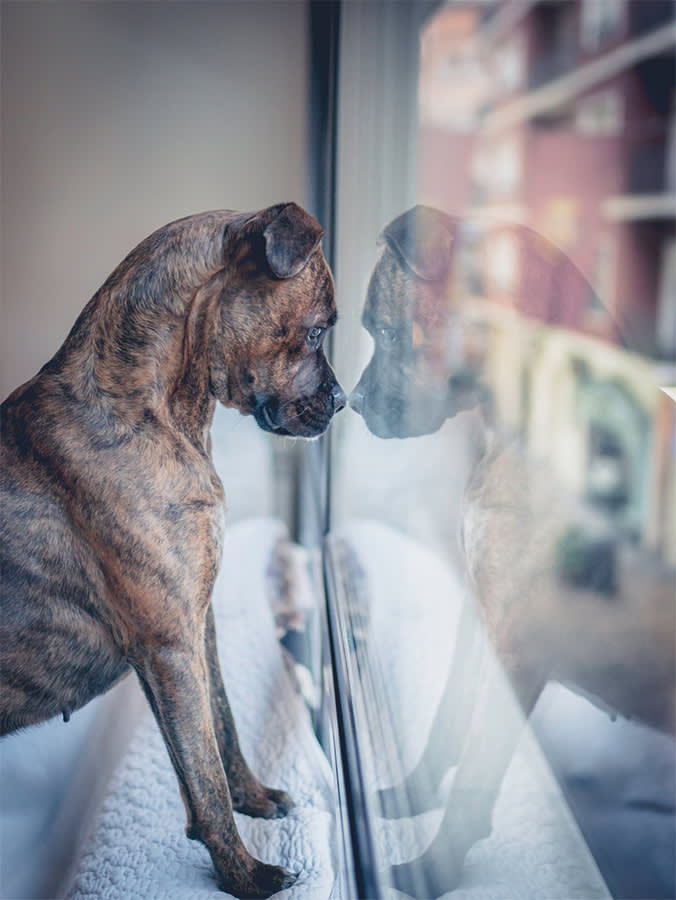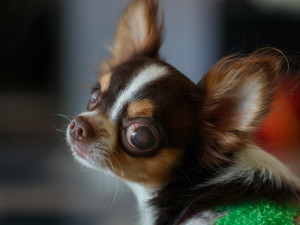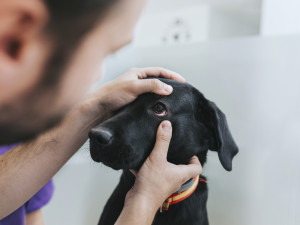What, Exactly, Can Dogs See?
Those soulful eyes mean everything to you – learn all about them

share article
A dog’s eyes are windows to their soul, offering a glimpse into their emotions and intentions. They come in a variety of colours, ranging from deep brown to piercing blue or even heterochromic, in which each eye has a different colour.
The size and shape of a dog’s eyes can vary greatly between breeds. Dogs are known for their ability to communicate through their eyes; a steady, direct gaze can convey confidence, while averted eyes may signal submission or discomfort. The sclera, or the white part of a dog’s eye, can vary in visibility, with some breeds showing more white than others. Additionally, a dog’s eyes have a reflective layer called the tapetum lucidum, which enhances their night vision.
Anatomy of a dog’s eye
The anatomy of a dog’s eye is very similar to that of a human’s, though vision differs greatly.
Cornea: a thin, smooth, transparent layer at the front of the eye. Trauma, ulceration and irritating chemicals can lead to changes in the clarity of the cornea.
Sclera: ‘whites of the eyes’. This tough outer layer can give clues about underlying health issues if it becomes yellow, red or black.
Conjunctiva: the mucous membranes that cover the eye (except the cornea) and inner eyelids. Allergies, environmental irritants and infections can cause the conjunctiva to become red and inflamed.
Iris: the coloured part of the eye. The muscles of the iris control the amount of light allowed into the eye by altering the size of the pupil. While the colour of a dog’s eyes and fur can be linked to hearing, a dog’s eye colour does not impact its vision.
Pupil: the black space in the middle of the iris. The pupil changes in size, allowing more or less light into the eye depending on the light’s intensity.
Lens: the lens sits behind the iris and is suspended by tiny muscles. The lens changes shape to focus light on to the retina. Cataract formation, which leads to cloudiness of the lens, can affect vision.
Retina: the retina is located at the back of the eye and has two types of special cells called photoreceptors – rods and cones. Rods detect light and movement. Cones detect colour. The retina converts light into signals that the brain perceives as vision.
Tapetum lucidum: the reflective layer behind the retina that reflects light back on to the retina to help dogs see in low light conditions. This structure makes dogs’ eyes seem to glow when light hits them at night. Some dogs, like blue-eyed Siberian Huskies, lack a tapetum lucidum.
What does a dog’s vision look like?
Many pet parents may wonder exactly how a dog sees the world, and how it differs from what they see. Dr Crystal Eng, a veterinary ophthalmologist, gives some insight. “Vision in humans and animals is made up of a variety of rods and cones,” says Dr Eng. “In humans, we are trichromatic, having three different cones for colour vision while dogs are dichromatic, having only two types of cones. Dogs see on a colour spectrum of blue and yellow. Unlike humans, dogs have difficulty noting the difference between reds and greens.”
How a dog’s eye is different from the human eye
There are a few physical and functional differences between a dog’s eye and a human eye. The difference in visible colour spectrumopens in a new tab is one of the most well-known disparities.
Regarding the physical differences: “The dog, along with many other animals, has third eyelids that function like a windshield wiper to help spread tears across the cornea and even protect the eye from injury or trauma,” says Dr Eng. “Another difference between the dog and humans is the tapetum, which gives the glowing appearance of eyes at night. The tapetum is a reflective layer within the eye that helps reflect the light coming into the eye at night so that vision in dim lighting is enhanced.”
Can dogs see colour?
A popular old myth about dog vision is that dogs are colourblind and can only see black, white and shades of grey. Not true. Dogs can see colours, but the spectrum is more limited than that perceived by humans. Dogs’ dichromatic vision is based on their retinas having cone photoreceptor cells that can only distinguish between blue and yellow colour waves.
You can use this info to your dog’s advantage. What colours do dogs see best? Blue and yellow. What colours can dogs not see? Dogs can’t distinguish between reds and greens. So when picking out exciting new toys, using training tools or dressing them in new gear, blues and yellows may be the way to go.
How far can dogs see?
Dogs’ vision is less sharp than that of humans. When evaluating vision in people, a measurement of visual acuity is used. Visual acuity determines how well someone can see shapes and details of objects at any given distance. In humans, 20/20 vision is considered normal. Using this measurement, researchers estimate that the average dog has a visual acuity of 20/75. This means that the average dog would need to be six metres away to differentiate an object that a person with normal eyesight can see from 23 metres away.
How well can dogs see during the day?
Dogs can see during the day, but they actually see better when there is less light. Though rare, some dogs have a genetic condition that causes the cones in the retina to degenerate. This leads to a condition called hemeralopia, or day blindness. These dogs cannot see in the bright sunlight, and some act as if the sunlight causes discomfort. Thankfully, this condition is uncommon but has been documented in multiple breeds, including Alaskan Malamutes, German Shorthaired Pointers, German Shepherds and Labrador Retrievers.
Do dogs have night vision?
Dogs don’t have night vision, per se, but they can see pretty well in low-light conditions. “Dogs have better vision in dim lighting than humans,” says Dr Eng. “Their eyes are built with functional aspects such as a larger pupil diameter, increased rod photoreceptor density, and the tapetum help to improve motion vision in dim lighting, which helps with things like hunting behaviour for survival.”
Dog peripheral vision
The position of a dog’s eyes impacts both their depth perception and their peripheral vision. A dog’s eyes tend to be set wider than a human’s. This increases the width of their visual field and gives them wider peripheral vision. This also means that there is less overlap between what each eye sees, resulting in less depth perception.
What are common eyesight problems in dogs?
Dog parents who notice an issueopens in a new tab with their dog’s eyes should get those eyes checked out ASAP. Loss of vision can occur for a number of reasons, and not all of them originate from the eye. Some common eye problems in dogs that can lead to vision changes include:
Trauma: penetrating wounds or blunt force trauma can cause irreversible damage to dog eyes.
Glaucoma: this occurs when there is increased intraocular pressure (pressure within the eye). High intraocular pressure can damage the retina and optic nerve, leading to blindness.
Cataractsopens in a new tab: cataracts occur when the lens of the eye becomes cloudy, blocking light from reaching the retina. They can be genetic or develop secondary to other health issues.
Diabetes: diabetic dogs have a higher risk of developing cataracts, which can lead to partial or full blindness.
Progressive retinal atrophy (PRA): this is a genetic condition in which a dog’s retina slowly deteriorates, leading to poor vision and eventually blindness.
Sudden Acquired Retinal Degeneration Syndrome (SARDS): this syndrome causes a sudden and rapid deterioration of the retina, causing blindness in days to weeks. The exact cause is unknown.
Inflammation: uveitis (inflammation of the layer between the sclera and retina) or optic neuritis (inflammation of the optic nerve) can both impact a dog’s vision.
How does age affect my dog’s eyesight?
Just like humans, canine vision can change with age. Many dog parents notice that their dog’s eyes become less clear with age, but this doesn’t always come with a noticeable change in vision. A common age-related change to a dog’s eye is the development of nuclear sclerosis. This is the cloudiness that slowly develops with age. It’s not a painful condition and does not lead to blindness.
Age-related changes to the lens, on the other hand, can decrease vision. “The lens sits within the eye and is used to focus light for vision,” says Dr Eng. “As we age the lens becomes more dense with time causing an opaque appearance that is often confused with a cataract. With the increase in opacity colour vision and night vision diminish with age.”
How can I help take care of my dog’s eyes?
Be sure to protect your dog’s eyes from possible hazards like chemical sprays, dust and excessive furopens in a new tab. Dr Eng provides some guidance for monitoring your dog’s eye health. “Regular monitoring of what is normal for your pet’s vision and appearance is important,” says Dr Eng. “The sudden appearance of squinting can be the first sign of major injury to the eye and may require an urgent visit to your veterinarian. Other signs such as heavy discharge, redness, cloudiness and change in vision should be further evaluated.”
How do dogs use their eyes to communicate?
For a dog, eye contact is important to communicate with people and each other. Dogs will use a loving gaze to show affection (or to sucker you out of a treat). They will stare at objects or animals with great determination to direct the attention of others. Dogs can also use direct eye contact (along with other social cues) to stand up to people or animals they perceive as threats.
Eye contact can also be avoided when dogs are fearful. “Dogs use their vision in part to understand what other dogs are communicating,” says Dr Eng. “Visual cues such as raised hackles or a wagging tail are important in communication between dogs. Although not their most important sense, visual cues are a big part of animal communication.”
Frequently asked questions
Can dogs see in complete darkness?
When compared to humans, dogs can see better in the dark because they have larger pupils, more rod photoreceptors (the special cells that receive light) and a tapetum lucidum.
Is dog eyesight better than human eyesight?
Dogs have less visual acuity than humans, meaning their vision is less sharp at certain distances. However, dogs can see better in dim light, have wider peripheral vision and can spot movement better than humans.
How can I tell if my dog has poor eyesight?
Your dog may be having problems with their vision if they are bumping into walls or furniture, having difficulty navigating their environment or having a hard time finding resources (like food, toys and bedding).

Dr. Alycia Washington, DVM, MS
Alycia Washington, DVM, is a small animal emergency veterinarian based in North Carolina. She works as a relief veterinarianopens in a new tab and provides services to numerous emergency and specialty hospitals. Dr. Washington is also a children’s book author and freelance writer with a focus on veterinary medicine. She has a special fondness for turtles, honey bees, and penguins — none of which she treats. In her free time, Dr. Washington enjoys travel, good food, and good enough coffee.
Related articles
![Reflection of a multi-colored rainbow on the face of a mixed breed dog sitting on the floor indoors]() opens in a new tab
opens in a new tabDog Vision: What Colours Do Dogs See?
They can’t take in as many colours as you can, but their world isn’t just black and white
![Hungary shepherd dog with hair covering its eyes]() opens in a new tab
opens in a new tabWhy You Should Trim Your Dog’s Fringe
Hint: they can’t see
![close up of Chihuahua dog's eye with cataracts]() opens in a new tab
opens in a new tabCommon Eye Problems in Dogs and How to Treat Them
Your dog sees you as their best friend, so keep those eyes healthy
![Two brown senior pointer dogs]() opens in a new tab
opens in a new tab‘Old Dog’ Vestibular Disease and Treatment
If you have an older dog, they could have a condition called idiopathic vestibular disease. Here’s everything you need to know






